
HMS Inflexible was one of three Invincible-class battlecruisers built for the Royal Navy before World War I and had an active career during the war. She tried to hunt down the German battlecruiser SMS Goeben and the light cruiser SMS Breslau in the Mediterranean Sea when war broke out and she and her sister ship Invincible sank the German armoured cruisers SMS Scharnhorst and SMS Gneisenau during the Battle of the Falkland Islands. Inflexible bombarded Turkish forts in the Dardanelles in 1915, but was damaged by return fire and struck a mine while maneuvering. She had to be beached to prevent her from sinking, but she was patched up and sent to Malta, and then Gibraltar for more permanent repairs. Transferred to the Grand Fleet afterwards, she damaged the German battlecruiser Lützow during the Battle of Jutland in 1916 and watched Invincible explode. She was deemed obsolete after the war and was sold for scrap in 1921.

The three Invincible-class battlecruisers were built for the Royal Navy and entered service in 1908 as the world's first battlecruisers. They were the brainchild of Admiral Sir John ("Jacky") Fisher, the man who had sponsored the construction of the world's first "all-big-gun" warship, HMS Dreadnought. He visualised a new breed of warship, somewhere between the armoured cruiser and battleship; it would have the armament of the latter, but the high speed of the former. This combination would allow it to chase down most ships, while allowing it to run from more powerful designs.

SMS Goeben was the second of two Moltke-class battlecruisers of the Imperial German Navy, launched in 1911 and named after the German Franco-Prussian War veteran General August Karl von Goeben. Along with her sister ship, Goeben was similar to the previous German battlecruiser design, Von der Tann, but larger, with increased armor protection and two more main guns in an additional turret. Goeben and Moltke were significantly larger and better armored than the comparable British Indefatigable class.

The Russian battleship Potemkin was a pre-dreadnought battleship built for the Imperial Russian Navy's Black Sea Fleet. She became famous during the Revolution of 1905, when her crew mutinied against their officers. This event later formed the basis for Sergei Eisenstein's 1925 silent film Battleship Potemkin.

SMS Breslau was a Magdeburg-class cruiser of the Imperial German Navy, built in the early 1910s and named after the Lower Silesian city of Breslau. Following her commissioning, Breslau and the battlecruiser Goeben were assigned to the Mittelmeerdivision in response to the Balkan Wars. After evading British warships in the Mediterranean to reach Constantinople, Breslau and Goeben were transferred to the Ottoman Empire in August 1914, to entice the Ottomans to join the Central Powers in World War I. The two ships, along with several other Ottoman vessels, raided Russian ports in October 1914, prompting a Russian declaration of war. The ships were renamed Midilli and Yavûz Sultân Selîm, respectively, and saw extensive service with the Ottoman fleet, primarily in the Black Sea against the Russian Black Sea Fleet.

The Imperatritsa Mariya-class battleships were the first dreadnoughts built for the Black Sea Fleet of the Imperial Russian Navy. All three ships were built in Nikolayev during World War I; two of the ships were built by the Rossud Dockyard and the third was built by the Associated Factories and Shipyards of Nikolayev. Two ships were delivered in 1915 and saw some combat against ex-German warships that had been 'gifted' to the Ottoman Empire, but the third was not completed until 1917 and saw no combat due to the disorder in the navy after the February Revolution earlier that year.

Imperatritsa Mariya was the lead ship of her class of three dreadnoughts built for the Imperial Russian Navy during World War I. She served with the Black Sea Fleet during the war and covered older pre-dreadnought battleships as they bombarded Ottoman facilities in 1915. The ship engaged the Ottoman light cruiser Midilli,(formerly the German SMS Breslau) several times without inflicting anything more serious than splinter damage. Imperatritsa Mariya was sunk at anchor in Sevastopol by a magazine explosion in late 1916, killing 228 crewmen. She was subsequently raised, but her condition was very poor. She was finally scrapped in 1926, after the end of the Russian Civil War.

Imperatritsa Ekaterina Velikaya was the second of three Imperatritsa Mariya-class dreadnoughts built for the Imperial Russian Navy during World War I. Completed in 1915, she was assigned to the Black Sea Fleet. She engaged the ex-German battlecruiser Yavûz Sultân Selîm once, but only inflicted splinter damage while taking no damage herself. The ship briefly encountered an Ottoman light cruiser, but mostly covered the actions of smaller ships during the war without firing her guns. These included minelaying operations off the Bosporus and anti-shipping sweeps of the coast of Anatolia. Imperatritsa Ekaterina Velikaya was renamed Svobodnaya Rossiya after the February Revolution of 1917.

The Evstafi class were a pair of pre-dreadnought battleships of the Imperial Russian Navy built before World War I for the Black Sea Fleet. They were slightly enlarged versions of the Potemkin, with increased armour and more guns. Numerous alterations were made as a result of experience in the Russo-Japanese War of 1904–5 that seriously delayed the completion of the two ships.
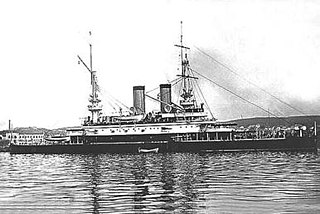
Tri Sviatitelia was a pre-dreadnought battleship built for the Imperial Russian Navy during the 1890s. She served with the Black Sea Fleet and was flagship of the forces pursuing the mutinous battleship Potemkin in June 1905. During World War I the ship encountered the German battlecruiser SMS Goeben twice, but never hit the German ship, nor was she damaged by her. From 1915 onward she was relegated to the coast bombardment role as she was the oldest battleship in the fleet. Tri Sviatitelia was refitting in Sevastopol when the February Revolution of 1917 began and she was never operational afterwards.
A naval race had developed in the Aegean after the end of the Balkan Wars, with the Ottoman government ordering several ships, including two dreadnoughts, in Britain. In the event, with the outbreak of World War I, one of these ships, including further two scout cruisers and four destroyers, were confiscated and pressed into service with the Royal Navy. This disappointed the Ottomans, contributing to their joining the Central Powers in the Great War.

Sarych is a headland located on the shore of the Black Sea at the southern extremity of the Crimean Peninsula.
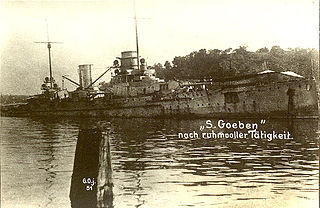
The Battle of Imbros was a naval action that took place during the First World War. The battle occurred on 20 January 1918 when an Ottoman squadron engaged a flotilla of the British Royal Navy off the island of Imbros in the Aegean Sea. A lack of heavy Allied warships in the area allowed the Ottoman battlecruiser Yavûz Sultân Selîm and light cruiser Midilli to sortie into the Mediterranean and attack the Royal Navy monitors and destroyers at Imbros before assaulting the naval base at Mudros.
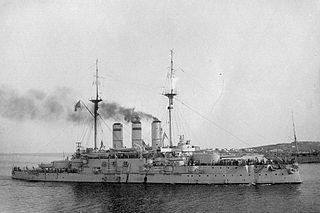
Evstafi was the lead ship of her class of two pre-dreadnought battleship of the Imperial Russian Navy's Black Sea Fleet. She was built before World War I and her completion was greatly delayed by changes made to reflect the lessons of the Russo-Japanese War of 1905.

Ioann Zlatoust was an Evstafi-class pre-dreadnought battleship of the Imperial Russian Navy's Black Sea Fleet. She was built before World War I and her completion was greatly delayed by changes made to reflect the lessons of the Russo-Japanese War of 1905. She was the second ship of her class.
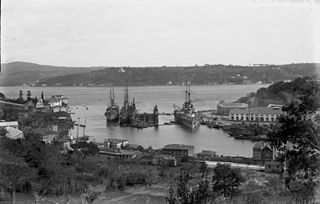
The Mediterranean Division was a division consisting of the battlecruiser SMS Goeben and the light cruiser SMS Breslau of the German Kaiserliche Marine in the early 1910s. It was established in response to the First Balkan War and saw action during the First World War. It was disbanded after the ships were transferred to the Ottoman Empire four years after their pursuit by the British battlecruisers Indomitable and Indefatigable and light cruisers Dublin and Gloucester.
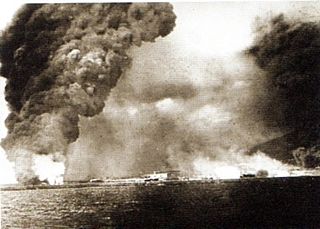
The Black Sea raid was an Ottoman naval sortie against Russian ports in the Black Sea on 29 October 1914, supported by Germany, that led to the Ottoman entry into World War I. The attack was conceived by Ottoman War Minister Enver Pasha, German Admiral Wilhelm Souchon, and the German foreign ministry.

On 8 January 1916 the Russian dreadnought Imperatritsa Ekaterina Velikaya and the Ottoman battlecruiser Yavuz Sultan Selim encountered one another in the Black Sea. After a brief exchange of fire the Ottomans withdrew.
The action of 10 May 1915 was a naval encounter between the Russian pre-dreadnought squadron and the Ottoman battlecruiser Yavuz Sultan Selim in the Black Sea. After a brief exchange of fire the Ottomans withdrew.

The Battle of the Bosporus was a naval engagement during World War I on 10 May [O.S. 27 April] 1915 between the Russian Black Sea Fleet and the German battlecruiser Goeben in the Black Sea, north of the Bosporus, resulting in a tactical victory for the Russians. The battle took place during the main operation of the Black Sea Fleet aimed at shelling the Bosporus fortifications. The action of the Goeben led to the interruption of the operation, but it did not manage to inflict significant damage to the Russian fleet, suffering only minor damage itself.

















